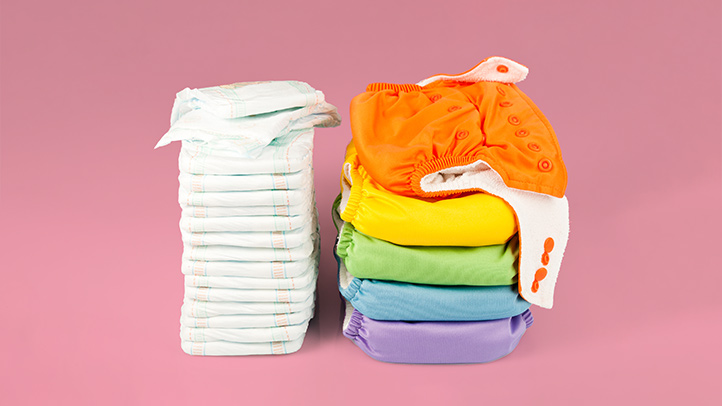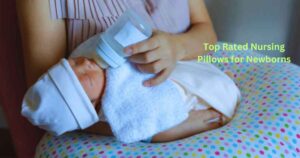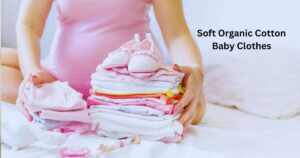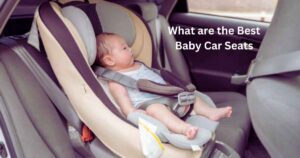Cloth diapers are reusable and eco-friendly, while disposable diapers are convenient and time-saving. Both have their own pros and cons.
Cloth diapers reduce environmental impact and are cost-effective over time. They require regular washing and can be bulkier. Disposable diapers offer convenience, especially for busy parents. They are easy to use and dispose of but contribute significantly to landfill waste.
Each family must weigh their priorities, such as budget, environmental concerns, and lifestyle, to make the best choice. Cloth diapers involve an initial investment but save money in the long run. Disposable diapers, on the other hand, provide hassle-free use but incur ongoing costs. Understanding these differences helps parents make informed decisions for their baby’s needs.
History Of Diapers
The history of diapers is fascinating. Diapers have evolved over centuries, adapting to cultural and technological advancements. Understanding their history helps us appreciate the choices we have today between cloth and disposable diapers.
Early Diaper Practices
In ancient times, people used natural materials for diapering. They used moss, animal skins, and grass. These early methods were simple and biodegradable.
Parents often used cloth strips or linen to wrap their babies. These cloths were washable and reusable. In some cultures, babies were left without diapers. Parents used elimination communication to manage waste.
In the 19th century, cloth diapers became more common. They were made from cotton and secured with safety pins. Families would wash and reuse these cloth diapers multiple times.
Rise Of Disposable Diapers
Disposable diapers were invented in the mid-20th century. The first disposable diaper was created by Marion Donovan in 1946. She used shower curtains to make a waterproof cover.
In 1961, Procter & Gamble introduced Pampers. These diapers were revolutionary. They provided convenience and hygiene. Pampers quickly became popular among parents.
Disposable diapers have evolved significantly. Modern disposables are ultra-absorbent and comfortable. They come in various sizes and designs, catering to different needs.
Here’s a comparison of early and modern diaper practices:
| Feature | Early Diapers | Modern Disposable Diapers |
|---|---|---|
| Materials | Moss, animal skins, grass | Super-absorbent polymers, breathable fabrics |
| Reusability | Washable and reusable | Single-use |
| Convenience | Labor-intensive | Easy to use |
| Environmental Impact | Biodegradable | Non-biodegradable |
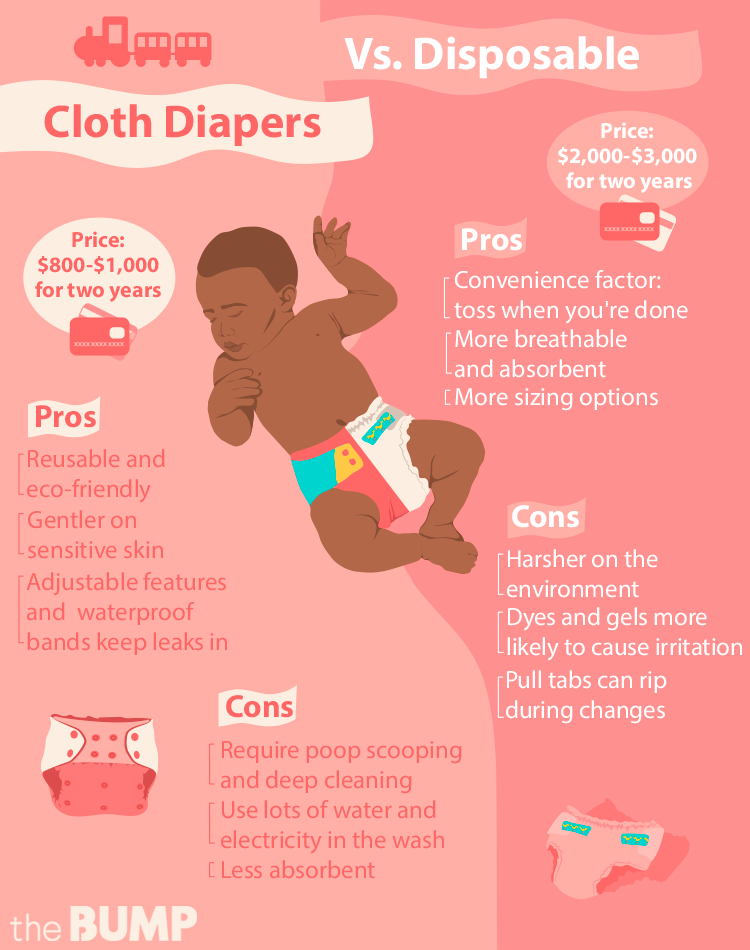
Credit: www.thebump.com
Environmental Impact
The choice between cloth diapers and disposable diapers significantly impacts the environment. Understanding the environmental footprint of each option helps parents make informed decisions.
Waste Generation
Disposable diapers generate a substantial amount of waste. An average baby uses about 5,000 diapers before potty training. These diapers end up in landfills, taking up to 500 years to decompose. This creates a massive waste problem.
On the other hand, cloth diapers produce less waste. They are reusable and can be used for multiple children. This reduces the number of diapers discarded, lowering the overall waste generated.
Resource Consumption
Disposable diapers consume a lot of resources during production. They require significant amounts of water, oil, and raw materials like wood pulp. Manufacturing disposable diapers also involves chemicals that can harm the environment.
Cloth diapers also consume resources, mainly water and energy for washing. However, they use fewer raw materials than disposables. The environmental impact of cloth diapers can be mitigated by using energy-efficient washing methods and line drying.
Here’s a quick comparison in a table format:
| Factor | Disposable Diapers | Cloth Diapers |
|---|---|---|
| Waste Generation | High (500 years to decompose) | Low (Reusable) |
| Water Consumption | High (Production) | Moderate (Washing) |
| Raw Materials | High (Wood pulp, oil) | Low (Cotton, bamboo) |
Choosing between cloth and disposable diapers involves weighing these environmental impacts. Parents can make a significant difference by considering these factors.
Cost Analysis
Parents often debate between cloth diapers and disposable diapers. One crucial factor is cost. Understanding the financial aspects helps in making an informed decision. Let’s delve into the cost analysis of cloth diapers vs. disposable diapers.
Initial Costs
Cloth diapers have a higher upfront cost. You need to buy a sufficient number to last between washes.
| Diaper Type | Initial Cost |
|---|---|
| Cloth Diapers | $200 – $500 |
| Disposable Diapers | $30 – $50 per month |
Disposable diapers have a lower initial cost. You only buy them as needed. Over time, the cost accumulates.
Long-term Savings
Cloth diapers offer significant long-term savings. Once purchased, they can be reused multiple times. This reduces the need for continuous buying.
- Reusable for multiple children
- Lower environmental impact
- Resale value after use
Disposable diapers are convenient but add up in cost over time. A baby can use 2,500 to 3,000 diapers in the first year alone.
- Average cost per diaper: $0.20 – $0.30
- Annual cost: $500 – $900
Over two years, disposable diapers can cost between $1,000 and $1,800.
Cloth diapers, despite the higher initial cost, offer savings in the long run.
Choosing cloth can save hundreds of dollars over time.

Credit: salemclothproject.org
Convenience Factors
Choosing between cloth diapers and disposable ones can be tough for parents. Understanding the convenience factors of each option can make the decision easier. Let’s explore their ease of use and the cleaning and maintenance involved.
Ease Of Use
Disposable diapers are very easy to use. You just put them on and throw them away after use. There’s no need to wash or dry them. They come with adhesive strips for a snug fit.
Cloth diapers require a bit more effort. You need to fold them and use pins or snaps to secure them. Some modern cloth diapers come in ready-to-use designs, but they still need to be washed after use.
Cleaning And Maintenance
Cleaning and maintaining disposable diapers is simple. You just throw them away after they get soiled. There’s no need to wash or sanitize them.
Cleaning and maintaining cloth diapers involves several steps. You need to rinse them, soak them, and then wash them in a washing machine. Some parents find this task time-consuming.
Here is a quick comparison:
| Factor | Disposable Diapers | Cloth Diapers |
|---|---|---|
| Ease of Use | Very easy | Needs more effort |
| Cleaning | Throw away | Wash and dry |
Health Considerations
Choosing between cloth and disposable diapers involves many health considerations. Understanding these can help parents make informed decisions. Here, we look at two key aspects: skin sensitivity and chemical exposure.
Skin Sensitivity
Babies often have very sensitive skin. Cloth diapers use natural fabrics like cotton. These materials are soft and less likely to irritate the skin.
Disposable diapers contain synthetic materials. These can sometimes cause rashes or allergic reactions. Parents must check how their baby’s skin reacts.
Here is a quick comparison:
| Cloth Diapers | Disposable Diapers |
|---|---|
| Natural fabrics | Synthetic materials |
| Less skin irritation | Potential for rashes |
Chemical Exposure
Disposable diapers often contain chemicals. These may include chlorine, dyes, and fragrances. Such chemicals can be harmful to a baby’s health.
Cloth diapers are free from these chemicals. They use safe, natural materials. This reduces the risk of chemical exposure.
Consider these points:
- Disposable diapers: May contain chlorine, fragrances, and dyes.
- Cloth diapers: Free from harmful chemicals.
User Experiences
Choosing between cloth diapers and disposable diapers can be a tough decision for many parents. Each option has its own set of advantages and challenges. To help you make an informed choice, let’s delve into the user experiences shared by parents and experts.
Parental Testimonials
Many parents have strong opinions about cloth diapers and disposable diapers. Here are some testimonials that shed light on their experiences.
- Jane, mother of two: “Cloth diapers are so soft on my baby’s skin. They save us a lot of money.”
- Tom, father of one: “I prefer disposable diapers. They are convenient, especially during travel.”
- Susan, eco-conscious mom: “Cloth diapers are better for the environment. I feel good about my choice.”
- Mark, busy dad: “Disposable diapers are quick and easy. No washing needed.”
Expert Opinions
Experts in childcare and environmental science also have valuable insights into the cloth vs. disposable diaper debate.
| Expert | Opinion |
|---|---|
| Dr. Emily Green, Pediatrician | “Cloth diapers can reduce diaper rash. They are less irritating.” |
| Dr. John Smith, Environmental Scientist | “Disposable diapers contribute significantly to landfill waste. Cloth diapers are reusable.” |
| Nurse Laura White | “Disposable diapers are often more absorbent. They can be better for overnight use.” |
These testimonials and expert opinions highlight the diverse experiences and perspectives on cloth diapers and disposable diapers. Each family must weigh their priorities and lifestyle needs to make the best choice for their baby.
Making The Switch
Switching from disposable diapers to cloth diapers can feel daunting. With the right tips and supplies, the change can be smooth and rewarding. Cloth diapers are eco-friendly and cost-effective. They also help reduce waste and are gentle on your baby’s skin.
Transition Tips
Making the switch to cloth diapers requires some planning. Follow these simple tips to ease the transition:
- Start Slowly: Begin by using cloth diapers part-time.
- Educate Yourself: Learn about different types of cloth diapers.
- Join Communities: Seek advice from cloth diapering groups online.
- Practice: Try cloth diapers at home before going out.
- Stay Organized: Keep a routine for washing and drying diapers.
Essential Supplies
Having the right supplies makes the switch easier. Here is a list of essentials:
| Item | Description |
|---|---|
| Cloth Diapers | Choose between pre-folds, all-in-ones, or pocket diapers. |
| Diaper Pail | Use a pail with a liner for storing dirty diapers. |
| Wet Bags | Keep wet bags in your diaper bag for soiled diapers. |
| Wipes | Consider using cloth wipes for an eco-friendly option. |
| Diaper Sprayer | Attach a sprayer to your toilet to clean off solid waste. |
Remember, switching to cloth diapers is a journey. Take it step by step and enjoy the benefits for your baby and the planet.

Credit: www.whattoexpect.com
Frequently Asked Questions
What Are The Benefits Of Cloth Diapers?
Cloth diapers are eco-friendly and reduce waste. They are cost-effective over time. They are gentle on baby’s skin and can be reused.
Are Disposable Diapers Convenient?
Yes, disposable diapers are very convenient. They are easy to use and dispose of. They are ideal for travel and busy parents.
How Do Cloth Diapers Impact The Environment?
Cloth diapers are reusable and reduce landfill waste. They require less raw materials over time. They are a more sustainable choice.
Do Disposable Diapers Cause Diaper Rash?
Disposable diapers can cause diaper rash in some babies. They contain chemicals that may irritate sensitive skin. Frequent changes can help reduce the risk.
Conclusion
Choosing between cloth and disposable diapers depends on your lifestyle and preferences. Cloth diapers are eco-friendly and cost-effective. Disposable diapers offer convenience and less laundry. Weigh the pros and cons of each to decide what suits your family best. Both options have their unique benefits, so pick what feels right for you.

